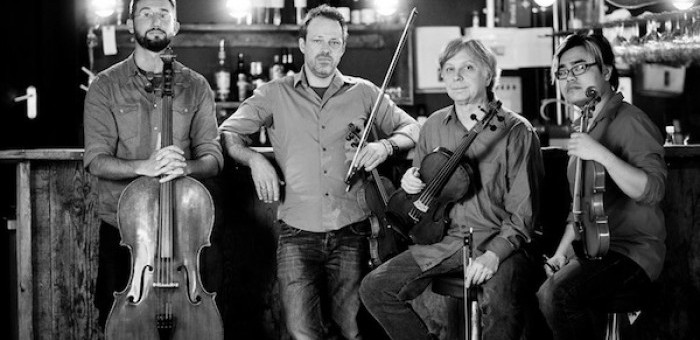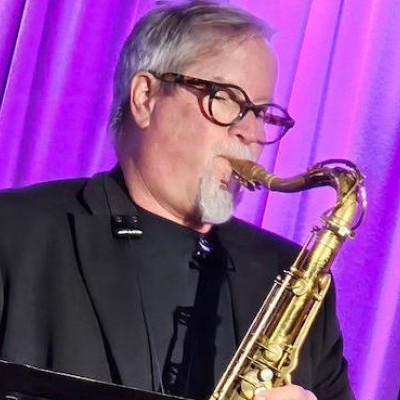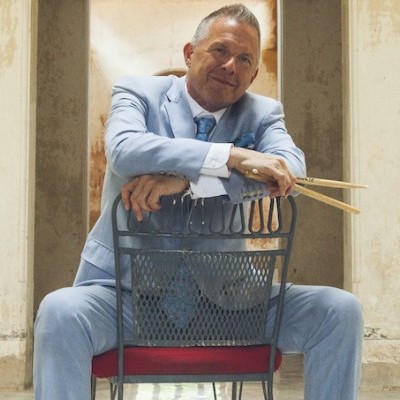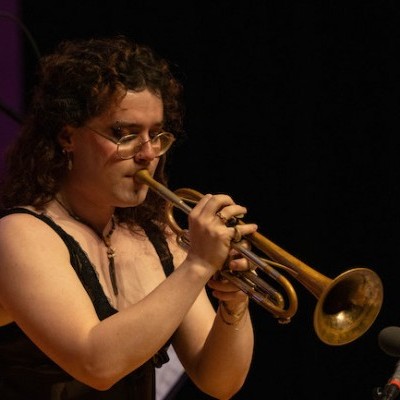Oct 28, 2025 10:47 AM
In Memoriam: Jack DeJohnette, 1942–2025
Jack DeJohnette, a bold and resourceful drummer and NEA Jazz Master who forged a unique vocabulary on the kit over his…

Sirius Quartet
(Photo: Philip Nemenz)On the pleasantly mild and not entirely calm night of June 17, aboard a gently rocking boat that has been docked off of Brooklyn Ferry Landing for almost 40 years, the Sirius Quartet presented a unique blend of composition and improvisation—something that they have been pursuing for more than 30 years.
The boat, christened Bargemusic, is one of New York City’s finer non-hall venues for classical music, with windows behind the stage looking out onto the East River and Lower Manhattan. Even though Sirius isn’t a classical group, the program did begin with a work by the baroque composer Henry Purcell and included a piece by American iconoclast Charles Ives.
To the extent that such things can be delineated, Sirius didn’t strike the appearance of a classical quartet, either. If anything, they looked like an old-time string band. And when, during violinist Gregor Huebner’s Purcell arrangement, violist Ron Lawrence bore down on his bow and cellist Jeremy Harman lapsed into a walking bass line, they gave some indication of their love for jazz.
Also unlike the traditional string quartet, the members of Sirius write much of their own material. The quartet’s new album, Paths Become Lines (Autentico Music/Naxos) features compositions by each member, as did the better part of the June 17 concert.
The quartet followed the Purcell revisions with the piece by Harman that gave the new album its title. A quick and heavy pulse set the foundation, eventually giving way to a pair of violin solos, blistering from Huebner, more melodic from Fung Chern Hwei. The two then escalated in a tandem improvisation before anchoring again for a tight conclusion.
Fung introduced his song “Ceili” as a “moment of tranquility or nostalgia after a huge festivity or celebration. When everybody left, all you saw was an empty room.” A plucked meter set by Lawrence, holding his viola flat against his chest, was soon picked up by the violins against a plaintive melody from the cello that painted the scene before Fung picked up the melody line for a melancholy solo.”
Introducing a single movement from Ives’ 1913 Quartet No. 2, Lawrence said, “I think you’ll hear that he was listening to a lot of John Zorn when he wrote this,” drawing a bit of knowing laughter. The quartet played the piece forcefully, with hard unison lines breaking for solo violin or romantic ensemble fragments. Even the boat seemed to pick up the tempo of its rocking. It also seemed to give them the energy they needed to attack Harman’s interlocking and layered “More Than We Are.”
As if to ensure they met the requirements of playing an ordinarily classical venue, the group closed with what Huebner introduced as “a whole string quartet,” his String Quartet No. 4, Opus 44, “The Wollheim Quartet.” This was the most formal delivery of the evening, with distinct parts and no gray areas.
The brisk first movement contrasted sharply with the long, overlapping tones and delicate dissonances of the second, with a lovely unaccompanied cello passage that Harman played magnificently, bowing most of it while adding expression with his left hand against the fingerboard. The rest of the strings returned with a fantastic fluidity, Huebner adding a percussive arco twist. The work was the high point of the evening, only strengthened by the comparatively freer interplay that preceded it—as if they had earned the right to adhere to form.
For the encore, the quartet played Huebner’s arrangement of “Eleanor Rigby.” As well worn as Beatles tunes are in classical and jazz (as well as country, r&b and Muzak), this interpretation was tasteful and inventive. The familiar melody unfolded, tied no doubt to the unsung lyrics in the minds of many in the audience, while the sky darkened and the lonely people of New York rushed by behind the players.

Jack DeJohnette boasted a musical resume that was as long as it was fearsome.
Oct 28, 2025 10:47 AM
Jack DeJohnette, a bold and resourceful drummer and NEA Jazz Master who forged a unique vocabulary on the kit over his…

“I’ve told students, ‘I don’t mind if you use AI for this or that project,’” says MIT’s Pascal Le Boeuf. “‘But you need to tell me.’”
Sep 18, 2025 11:14 AM
A standard joke when it comes to discussing artificial intelligence, or AI, is that it’s developing so rapidly that…

Chuck Manning Works for NASA … and plays jazz.
Sep 18, 2025 11:23 AM
Congratulations! After years of study, you’ve earned your degree in jazz performance. But let’s face it: Making a…

Always a sharp dresser, Farnsworth wears a pocket square given to him by trumpeter Art Farmer. “You need to look good if you want to hang around me,” Farmer told him.
Sep 23, 2025 11:12 AM
When he was 12 years old, the hard-swinging veteran drummer Joe Farnsworth had a fateful encounter with his idol Max…

“Make time and energy to meet people and make friends,” suggests Millie Ahearn, a student at DePaul University.
Sep 18, 2025 11:32 AM
For many students, the transition into a collegiate jazz program can feel overwhelming — new peers, unfamiliar…